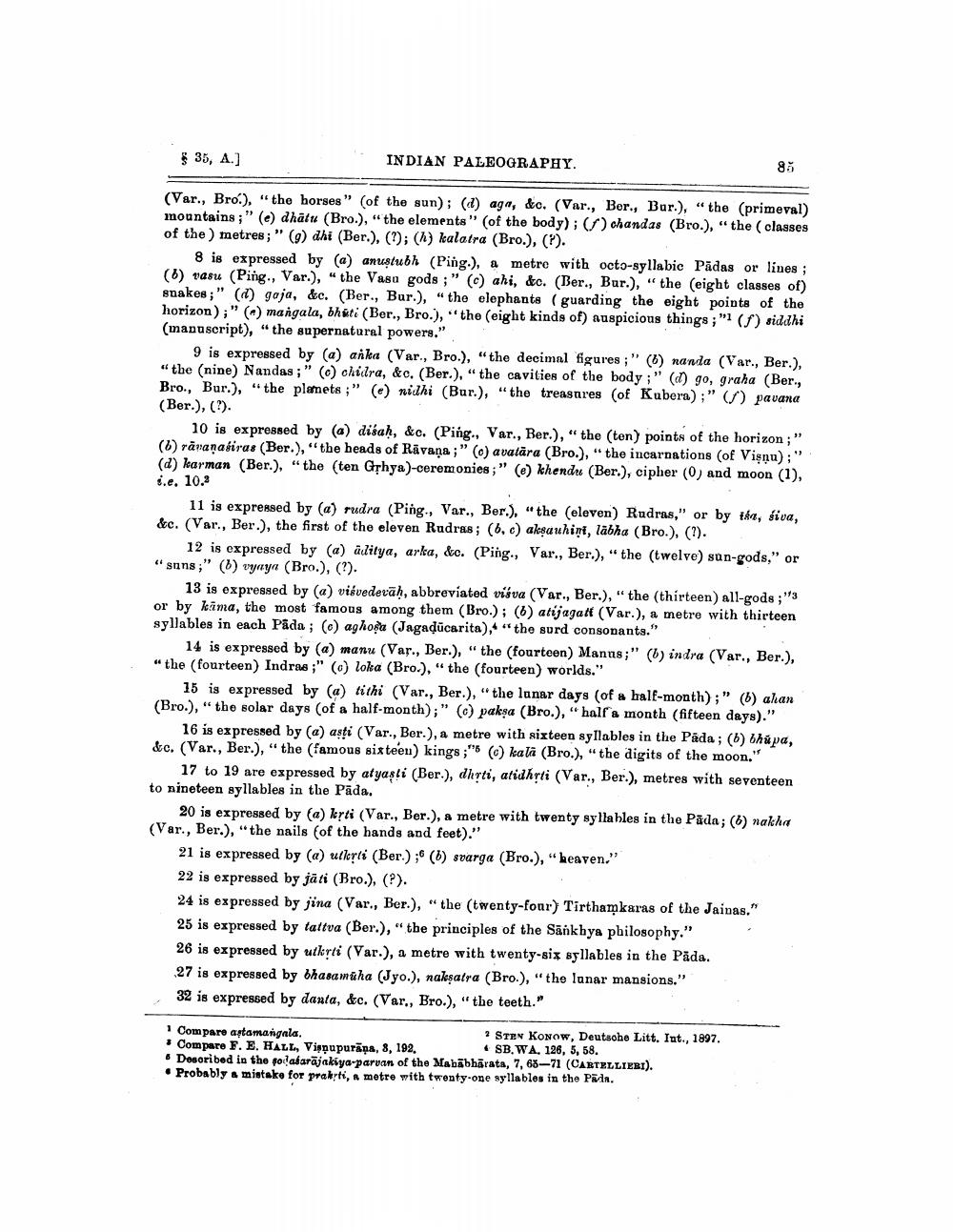________________
$ 35, A.]
INDIAN PALEOGRAPHY.
87
(Var., Bro.), "the horses" (of the sun); (d) aga, &c. (Var., Bor., Bur.), “the (primeval) mountains ;" (e) dhatu (Bro.), " the elements" (of the body); chandas (Bro.)," the classes of the) metres ; " (9) dhi (Ber.), (1); (h) kalatra (Bro.), (”).
8 is expressed by (a) anuştubh (Ping.), a metre with octo-syllabic Pādas or lines ; (6) vasu (Ping., Var.)," the Vasu gods;" (c) ahi, &c. (Ber., Bur.)," the eight classes of) snakes;" (d) gaja, &c. (Ber., Bur.), "the elephants (guarding the eight points of the horizon);" @ mangala, bhuti (Ber., Bro.), "the (eight kinds of) auspicious things;" (s) siddhi (manuscript), "the supernatural powers."
9 is expressed by (a) aika (Var., Bro.), “the decimal figures ;" (6) nanda (Var., Ber.), “the (nine) Nandas ; " () chidra, &c. (Ber.), "the cavities of the body;" (1) go, graha (Ber., Bro., Bur.), "the planets ;” (e) nidhi (Bur.), “the treasures (of Kubera);" (/) pavana (Ber.), (?).
10 is expressed by (a) diśaḥ, &c. (Ping., Var., Ber.), "the (ten) points of the horizon;" (6) rāvanabiras (Ber.), the heads of Rävana;" (c) avatara (Bro.), the incarnations (of Vienu);" (d) karman (Ber.), "the (ten Grhya)-ceremonies;" @ khendu (Ber.), cipher (0) and moon (1), s.e. 10.3
11 is expressed by (a) rudra (Ping., Var., Ber.), "the (eleven) Rudras," or by tát, siva, &c. (Var., Ber.), the first of the eleven Rudras; (b, c) aksauhini, lābha (Bro.), (?).
12 is expressed by (a) aditya, arka, &c. (Ping., Var., Ber.), "the (twelve) sun-gods," or "suns;" (6) vyayn (Bro.), (?).
13 is expressed by (a) vikvedevāh, abbreviated visva (Var., Ber.), "the (thirteen) all-gods;"3 or by kama, the most famous among them (Bro.); (6) atijagat (Var.), a metre with thirteen syllables in each Pada ; (c) aghoa (Jagadūcarita),4 "the surd consonants."
14 is expressed by (a) manu (Var., Ber.), "the (fourteen) Manus;" (6) indra (Var., Ber.), "the (fourteen) Indras;" (6) loka (Bro.)," the (fourteen) worlds."
15 is expressed by (a) tithi (Var., Ber.)," the lanar days (of a half-month);" (6) ahan (Bro.)," the solar days (of a half-month);" () paksa (Bro.), "half a month (fifteen days)."
16 is expressed by (a) asti (Var., Ber.), a metre with sixteen syllables in the Páda; (6) bhapa, &c. (Var., Ber.)," the famous sisteeu) kings;"5 () katā (Bro.), " the digits of the moon."
17 to 19 are expressed by atyasli (Ber.), dhiti, atidhrti (Var., Ber.), metres with seventeen to nineteen syllables in the Pāda.
20 is expressed by (a) kyti (Var., Ber.), a metre with twenty syllables in the Pada; (6) nakha (Var., Ber.), "the nails of the hands and feet)."
21 is expressed by (a) ullerti (Ber.) ;6 () svarga (Bro.), "heaven." 22 is expressed by jāti (Bro.), (?). 24 is expressed by jina (Var., Ber.), "the twenty-four) Tirthamkaras of the Jainas." 25 is expressed by tattva (Ber.), "the principles of the Sānkhya philosophy." 26 is expressed by utkyti (Var.), a metre with twenty-six syllables in the Päda. 27 is expressed by bhasamaha (Jyo.), nakşalra (Bro.)," the lunar mansions." 32 is expressed by danta, &c. (Var., Bro.), " the teeth."
Compare aptamangala.
? STEN KONow, Deutsche Litt. Int., 1897. • Compare F. E. HALL, Vişnupurāņa, 8, 192,
• SB.WA, 126, 5, 58. • Desoribed in the folalarājakiya parvan of the Mabibharata, 7, 68-71 (CARTELLIERI). • Probably & mistake for prakti, A metre with twenty-one syllables in the Pala.




